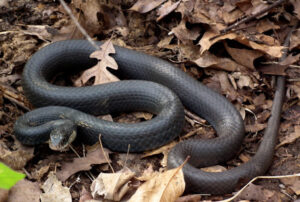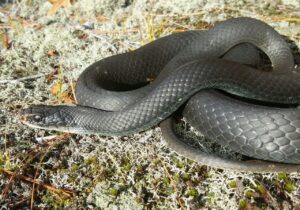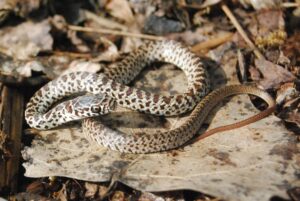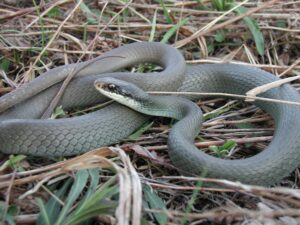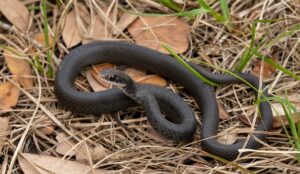The eastern racer or North American racer is a highly active, fast-moving, and diurnal colubrid endemic to Central and North America. Equipped with excellent vision, the curious snakes are often seen raising their heads above the grass to get a view of what is around them.
Scientific Classifications
- Suborder:Serpentes
- Family:Colubridae
- Genus:Coluber
- Species:C. constrictor
Conservation Status
Subspecies
This snake has eleven recognized subspecies. They are collectively known as eastern racers and are sometimes referred to as ‘runner’ instead of ‘racer’ in their common names.
- Buttermilk racer (Coluber constrictor anthicus)
- Northern black racer (Coluber constrictor constrictor)
- Tan racer (Coluber constrictor etheridgei)
- Eastern yellow-bellied racer (Coluber constrictor flaviventris)
- Blue racer (Coluber constrictor foxii)
- Brown-chinned racer (Coluber constrictor helvigularis)
- Black-masked racer (Coluber constrictor latrunculus)
- Mexican racer (Coluber constrictor Oaxaca)
- Everglades racer (Coluber constrictor paludicola)
- Southern black racer (Coluber constrictor priapus)
- Western yellow-bellied racer (Coluber constrictor mormon)
Description
Size
Their total length, including the tail, is in the range of 20-60 in (50-152 cm), depending on the subspecies. The maximum recorded length is 73 in (185.4 cm). Typically, an adult weighs around 1.226 lb (556 g) with very little size difference between the sexes.
Color and Appearance
Most of the subspecies are solid-colored, as their common names imply. The patterns vary a lot among the subspecies. All of them have lighter-colored bellies in light tan, white, or yellow.
The juveniles have more striking patterns with a mid-dorsal row of dark blotches against a light ground color. There is no pattern on their tails. As they grow old, their back color darkens while the pattern disappears.
Are They Dangerous to Humans
True to its name, the eastern racer is very fast and usually flees from a potential predator. But if cornered, it puts up a vigorous fight, biting often and hard. If handled, it defecates, writhes, and releases a foul-smelling musk from its cloaca. They also vibrate their tails, sounding a lot like rattlesnakes when they are among dry leaves.
Eastern Racers at a Glance
Distribution
It can be found throughout the US, east of the Rockies, but also ranges south into Guatemala, Mexico, and Belize and north into Canada.
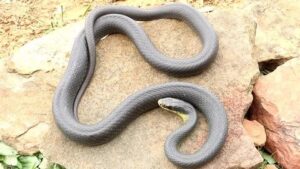
Habitat
They are often found near water but can also inhabit trash piles, brush, swamps, roadsides, and suburbia. It is the most common snake in the residential neighborhoods of Florida. They prefer open, grassland-type habitats where their speed and keen eyesight can be used to their full potential. But they are also found in light forests and even semi-arid areas. They are usually not far from an area with cover that can be used for hiding.
Though they spend most of their time on the ground, the good tree climbers can be found in trees and shrubs looking for chances to raid nests for their food.
Lifespan
It lives for over 10 years in the wild.
Predators
Eastern racers are eaten by dogs, cats, coyotes, and different birds.
Diet
It eats toads, frogs, lizards, small turtles, other snakes, small rodents, and other mammals (as big as small cottontail rabbits). Some species climb trees to eat chicks, small adult birds like canaries, finches, and thrashers, and their eggs. The juveniles feed on soft-bodied insects and other small invertebrates, small reptiles (including snakes, lizards, and their eggs), small frogs, shrews, and young rodents.
Despite its specific name, constrictor, it doesn’t employ constriction or suffocation to kill its prey. It subdues struggling prey by pinning its body, pressing a few coils against it to hold it in place. The smaller preys are usually swallowed alive.
Reproduction
Oviparous (lays eggs that hatch outside the body)
Mating occurs in spring from April till early June. After around a month, a female lays 3-30 eggs in a hidden nest site like an abandoned rodent burrow, a hollow log, or under a rock. North American racers lay their eggs in communal nesting sites, where multiple snakes, even those from other species, deposit their eggs together. They hatch in early fall, with the juveniles being 8-10 in (20-26 cm) in total length. They become mature after 2 years.
Source
projectnoah.org, vtherpatlas.org, sdherps.org, ak.picdn.net, atlas.ohparc.org, scparc.org

